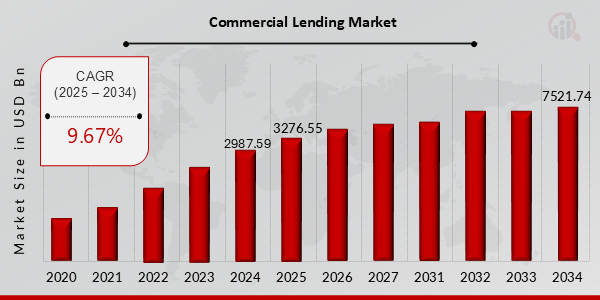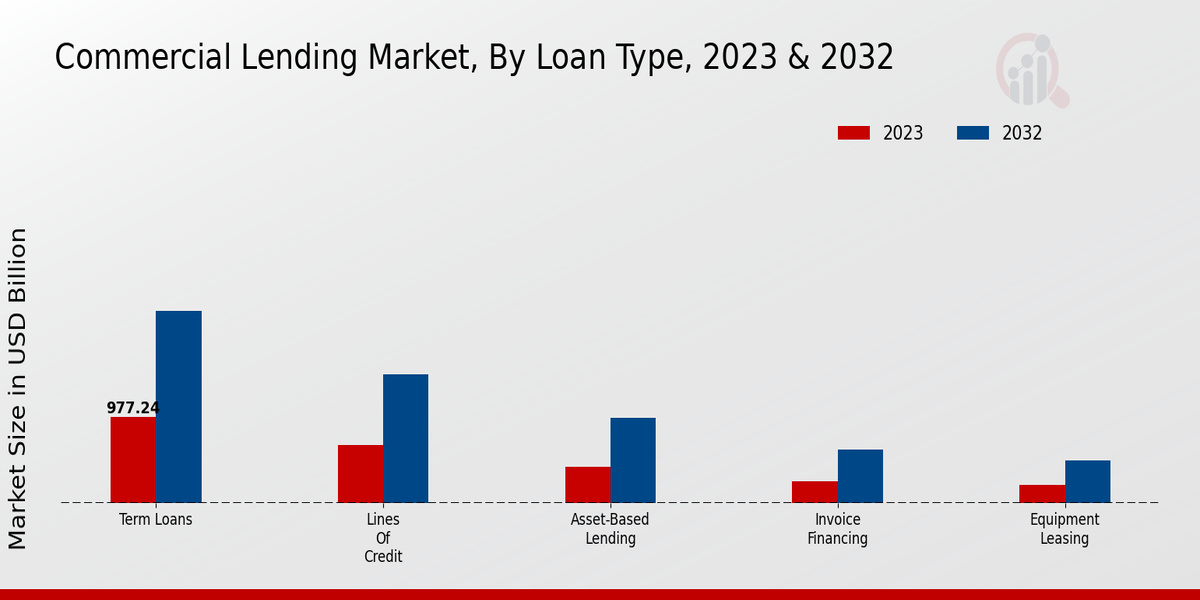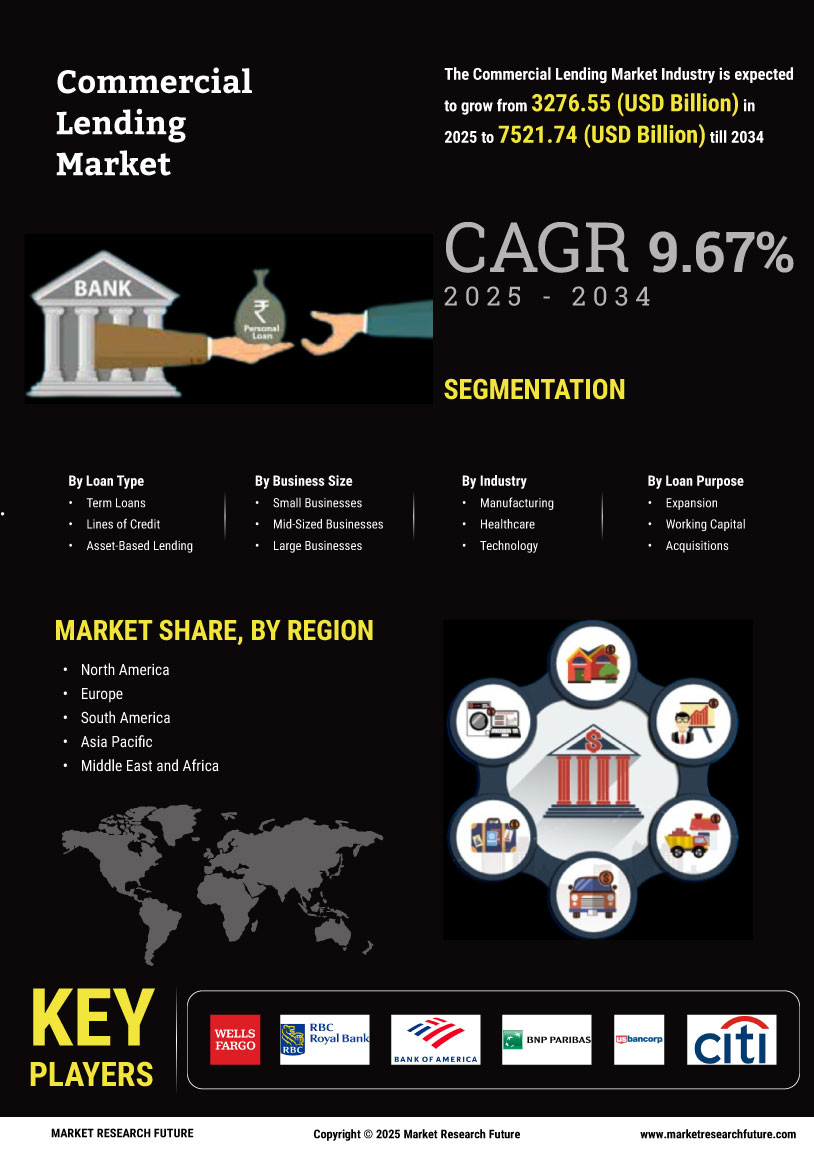Global Commercial Lending Market Overview:
The Commercial Lending Market Size was estimated at 2987.59 (USD Billion) in 2024. The Commercial Lending Market Industry is expected to grow from 3276.55 (USD Billion) in 2025 to 7521.74 (USD Billion) till 2034, exhibiting a compound annual growth rate (CAGR) of 9.67% during the forecast period (2025 - 2034).
Key Commercial Lending Market Trends Highlighted
Emerging market economies are embracing digital lending to enhance financial inclusion and access to credit. Integration of artificial intelligence and machine learning is reshaping credit assessment processes, reducing the time and effort involved in loan origination. Banks and non-bank lenders are implementing robust digital platforms to streamline loan applications and improve customer experiences.
Key market drivers include rising demand for working capital and expansion financing, the increasing prevalence of small and medium-sized enterprises, and favorable government initiatives to support business growth. Opportunities lie in the expansion of alternative lending channels, such as peer-to-peer lending and crowdfunding, as well as the development of tailored financing solutions for specific industries and sectors.
Notable trends include the adoption of sustainability-linked loans, which tie loan terms to environmental, social, and governance (ESG) performance, and the growing importance of data analytics in credit risk management. Lenders are leveraging advanced data analytics to assess creditworthiness, identify potential risks, and optimize underwriting strategies. The commercial lending market continues to evolve rapidly, with a focus on digitalization, innovation, and sustainability.

Source: Primary Research, Secondary Research, MRFR Database and Analyst Review
Commercial Lending Market Drivers
Increasing Demand for Business Loans
The commercial lending market is primarily driven by the increasing demand for business loans from various industries. Small and medium-sized enterprises (SMEs) are the major contributors to this demand, seeking funding for expansion, working capital, and equipment purchases. Large corporations also rely on commercial loans for project financing, acquisitions, and other strategic initiatives. The growing number of businesses and their need for capital to fuel their operations are driving the growth of the commercial lending market.The increasing availability of online lending platforms has made it easier for businesses to access commercial loans.
These platforms offer a streamlined application process, faster approval times, and competitive interest rates. The convenience and efficiency of online lending have significantly contributed to the growth of the commercial lending market. Furthermore, government initiatives and programs aimed at supporting small businesses and entrepreneurs have stimulated the demand for commercial loans.Through such actions, banks and other financial institutions are attracted to lending in form of favorable terms, loan guarantees, and other incentives for small businesses.
The growth of the commercial lending market is expected to continue being pushed by the increasing demands for business loans as well as more financing options available.
Government Regulations and Compliance
The commercial lending market is heavily regulated by government agencies to ensure the stability and integrity of the financial system. Regulations aim to protect consumers, prevent fraudulent activities, and maintain fair lending practices. Compliance with these regulations requires financial institutions to implement robust risk management systems, conduct thorough due diligence on borrowers, and adhere to strict reporting and disclosure requirements.The increasing complexity of regulatory requirements has led to higher compliance costs for financial institutions. However, these regulations also provide a level of assurance to borrowers and investors, contributing to the stability and growth of the commercial lending market.
Technological Advancements
Technological advancements are transforming the commercial lending process, making it more efficient, accessible, and data-driven. The adoption of cloud computing, artificial intelligence (AI), and machine learning (ML) enables financial institutions to automate tasks, improve credit risk assessment, and enhance customer service. AI-powered credit scoring models analyze vast amounts of data to assess borrower creditworthiness more accurately and quickly.This reduces the time and effort required for loan approvals, allowing financial institutions to process more applications and reach a wider pool of borrowers.
Additionally, mobile banking and online lending platforms provide convenient and user-friendly interfaces for businesses to apply for and manage their loans.
Commercial Lending Market Segment Insights:
Commercial Lending Market Loan Type Insights
The Loan Type segment is a significant factor in the dynamics of the Commercial Lending Market. It includes a range of sub-segments that focus on the different needs that financing might have for a business. Term Loans: These are long-term financing options, the repayment of which follows a fixed schedule of interest and agreed times at which payments will be made. In 2023, the Commercial Lending Market for term loans amounted to approximately USD 1,200 billion.
It is expected to expand and reach USD 1,800 billion by 2030, growing at a CAGR of 5.6%.Lines of Credit: These give a business a certain flexibility. A line of credit allows a borrower to access a sum of money defined with a borrower but not to obligate them to buy what they initially said they would. Starting at USD 800 in 2023, the market for lines of credit is projected to grow to USD 1,200 billion by 2030, growing at a CAGR of 5.1%.
Asset-Based Lending: Asset-based lending is a lending channel that proceeds with an asset as collateral: inventory, account receivables, or real estate. This type of financing is gaining more and more popularity and is estimated to expand rapidly.In 2023, the Commercial Lending Market for asset-based lending amounted to USD 500 billion. By 2030, it will have grown to USD 800 billion, growing at a CAGR of 5.9%. Invoice Financing: This type of financing provides a facility that purchases the firm’s outstanding accounts receivable and lets the firm take immediate payment.
It is a rapidly developing segment because of the rise in the use of e-invoices and the need for adequate working capital. Starting at USD 300 billion in 2023, the market for invoice financing should reach USD 500 billion by 2030, with a CAGR of 7.1%.Equipment Leasing: This type of financing is operational and provides a business with a certain piece of equipment necessary to perform their tasks without forcing them to buy it at the outset. In 2023, the Commercial Lending Market for equipment leasing amounted to USD 250 billion.
It should rise to USD 400 billion by 2030, growing at a CAGR of 6.3%. Some of the factors for the growing importance of these loan-type sub-segments are the greater need from SMEs for financing, the development of better lending platforms through the use of technology, and the need for more flexible and efficient solutions taking the shape of alternatives consolidating themselves on the market.Commercial lenders are well aware of these expected developments and are already beginning to adapt to them, adjusting their products in a way that guarantees all market actors a heightened level of innovation and competition.

Source: Primary Research, Secondary Research, MRFR Database and Analyst Review
Commercial Lending Market Business Size Insights
The Commercial Lending Market segmentation by business size includes small businesses, mid-sized businesses, and large businesses. In 2023, the small businesses segment accounted for the largest share of the market, at 45%. This is due to the large number of small businesses operating globally and their increasing need for financing to support their operations and growth.
The mid-sized businesses segment is expected to grow at the highest CAGR of 10% from 2023 to 2032, driven by the increasing demand for financing from these businesses to expand their operations and compete with larger businesses.The large businesses segment is expected to account for the second-largest share of the market in 2032, at 35%.
Commercial Lending Market Industry Insights
The Commercial Lending Market segmentation by Industry reveals significant opportunities across key sectors. In 2023, the Manufacturing industry held a dominant share of Commercial Lending Market revenue, owing to the high demand for financing to support capital-intensive projects, equipment purchases, and working capital requirements. The Healthcare industry is projected to exhibit robust growth, driven by the increasing need for funding for healthcare infrastructure, medical equipment, and research and development initiatives.
The Technology industry is expected to witness a surge in demand for commercial lending as businesses invest heavily in digital transformation, cloud computing, and artificial intelligence.The Retail industry is also poised for growth, supported by the expansion of e-commerce and the need for financing for store renovations, inventory management, and marketing campaigns. The Construction industry presents significant lending opportunities as businesses seek funding for infrastructure projects, residential and commercial real estate development, and construction equipment purchases. These industry-specific insights provide valuable guidance for commercial lenders to tailor their products and services to meet the unique needs of each sector.
Commercial Lending Market Loan Purpose Insights
The Loan Purpose segment plays a crucial role in shaping the dynamics of the Commercial Lending Market. Among the various loan purposes, 'Expansion' captured a significant market share in 2023 and is anticipated to maintain its dominance throughout the forecast period.
The increasing demand for funds to support business growth, including capital expenditures, new product development, and expansion into new markets, is driving the growth of this segment. 'Working Capital' also holds a substantial portion of the market as businesses seek financing to meet their short-term operational expenses, such as inventory purchases, salaries, and rent.'Acquisitions' is another key loan purpose, as companies explore strategic mergers and acquisitions to expand their market reach, enhance their product offerings, and gain competitive advantages. 'Refinancing' and 'Debt Consolidation' are other notable segments, representing the need for businesses to restructure their existing debt obligations and improve their financial position.
Overall, the Loan Purpose segment provides valuable insights into the specific financing needs of businesses and the evolving trends in the Commercial Lending Market.
Commercial Lending Market Lender Type Insights
The lender-type segment of the Commercial Lending Market is highly fragmented, with various types of lenders catering to the diverse needs of businesses. Banks hold a dominant position, accounting for a majority of the market share due to their extensive branch networks, established relationships with businesses, and comprehensive financial services offerings.
Credit unions, primarily member-owned cooperative financial institutions, play a significant role in local communities, focusing on providing financial services to their members, including commercial lending.Online lenders, leveraging technology and data analytics, have emerged as a growing force in the market, offering convenient and often more accessible financing options to businesses. Private lenders, typically non-bank financial institutions, provide specialized financing solutions to businesses that may not qualify for traditional bank loans. Government-backed lenders, such as the Small Business Administration (SBA) in the United States, offer loan programs with favorable terms and conditions to support small businesses and entrepreneurs.
The growth of online lending and the increasing demand for alternative financing solutions are expected to drive the market expansion for non-bank lenders in the coming years.
Commercial Lending Market Regional Insights
The Commercial Lending Market is segmented by region into North America, Europe, APAC, South America, and MEA. The North American region is expected to hold the largest market share in 2023, with a value of 985.6 billion USD. The European region is expected to follow with a market value of 654.2 billion USD. The APAC region is expected to experience the highest growth rate, with a CAGR of 10.2% over the forecast period.
The South American and MEA regions are expected to have smaller market shares compared to the other regions but are expected to grow at a steady pace.The growth in the Commercial Lending Market can be attributed to factors such as increasing demand for loans from businesses, favorable government policies, and technological advancements.

Source: Primary Research, Secondary Research, MRFR Database and Analyst Review
Commercial Lending Market Key Players And Competitive Insights:
Major players in Commercial Lending Market are continuously seeking opportunities to expand their portfolio and strengthen their position in the market. Leading Commercial Lending Market players are focusing on innovation and technological advancements to meet the evolving needs of customers. They are also adopting various strategies such as partnerships, acquisitions, and collaborations to enhance their capabilities and gain competitive advantage. The Commercial Lending Market industry is characterized by intense competition among existing players, driven by factors such as product differentiation, pricing strategies, and customer loyalty.
To stay competitive, companies are emphasizing customer-centric approaches, offering tailored solutions that meet specific business requirements.Bank of America Corporation, a leading player in the Commercial Lending Market, provides a comprehensive range of financial products and services to corporate and institutional clients worldwide. The company has a strong global presence and offers a wide array of lending solutions, including term loans, revolving credit facilities, and project finance. Bank of America Corporation is known for its strong financial performance, industry expertise, and commitment to sustainability.Citigroup Inc., another major player in the Commercial Lending Market, is a leading global financial services company.
The company offers a diverse portfolio of banking, investment management, and consumer finance products and services to corporate, institutional, and individual clients. Citigroup Inc. has a significant presence in the commercial lending market, providing customized lending solutions to businesses of various sizes and industries. The company is recognized for its global reach, financial strength, and innovative approach to lending.
Key Companies in the Commercial Lending Market Include:
Commercial Lending Market Industry Developments
The Commercial Lending Market is expected to reach a valuation of USD 5700.0 Billion by 2032, exhibiting a CAGR of 9.67% during the forecast period of 2024-2032. Some recent developments in the market include:
Increased demand for commercial loans due to rising business investments.Growing popularity of alternative lending platforms.The emergence of new technologies such as blockchain and artificial intelligence.Expansion of commercial lending services into emerging markets.Growing focus on sustainability and green lending.
Commercial Lending Market Segmentation Insights
Commercial Lending Market Loan Type Outlook
Commercial Lending Market Business Size Outlook
Commercial Lending Market Industry Outlook
Commercial Lending Market Loan Purpose Outlook
Commercial Lending Market Lender Type Outlook
- Government-Backed Lenders
Commercial Lending Market Regional Outlook
| Report Attribute/Metric |
Details |
| Market Size 2024 |
USD 2987.59 Billion |
| Market Size 2025 |
USD 3276.55 Billion |
| Market Size 2034 |
USD 7521.74 Billion |
| Compound Annual Growth Rate (CAGR) |
9.67% (2025-2034) |
| Base Year |
2024 |
| Market Forecast Period |
2025-2034 |
| Historical Data |
2020-2023 |
| Market Forecast Units |
USD Billion |
| Key Companies Profiled |
Wells Fargo, RBC, Bank of America, BNP Paribas, US Bancorp, Citigroup, Barclays, HSBC, Credit Suisse, JPMorgan Chase, TD Bank, Goldman Sachs, Santander, PNC Financial Services Group, Morgan Stanley |
| Segments Covered |
Loan Type, Business Size, Industry, Loan Purpose, Lender Type, Regional |
| Key Market Opportunities |
Digitalization of Commercial LendingAlternative Lending OptionsGrowing Demand for Small Business LoansIncreased Risk Tolerance in Commercial BankingCross-border Lending Expansion |
| Key Market Dynamics |
Rising demand for working capital Surge in business expansion and infrastructure developmentShift towards alternative lending Growth of fintech and online platforms offering competitive rates.Government initiatives Stimulus packages and loan schemes supporting businesses impacted by economic downturnsIncreased regulatory compliance Stricter lending standards and risk management practicesTechnological advancements Integration of artificial intelligence and machine learning for credit assessment and risk mitigation |
| Countries Covered |
North America, Europe, APAC, South America, MEA |
Frequently Asked Questions (FAQ):
The Commercial Lending Market is expected to reach a market size of USD 7521.74 billion by 2034, growing at a CAGR of 9.67% from 2025 to 2034. This growth is attributed to the increasing demand for commercial loans from businesses to expand their operations, fund working capital, and meet other financial needs.
The Asia-Pacific region is expected to dominate the Commercial Lending Market throughout the forecast period. This dominance is attributed to the rapidly growing economies in the region, particularly China and India, which are driving the demand for commercial loans to support infrastructure development, industrialization, and business expansion.
Commercial loans are primarily used by businesses for various purposes, including capital expenditures, working capital management, debt refinancing, mergers and acquisitions, and real estate financing. These loans provide businesses with the necessary funds to expand their operations, invest in new technologies, and meet their financial obligations.
The Commercial Lending Market is highly competitive, with numerous players operating on a global and regional scale. Some of the key competitors in the market include: - Bank of America Corporation - JPMorgan Chase & Co. - Citigroup Inc. - Wells Fargo & Company - The Goldman Sachs Group, Inc. - Morgan Stanley - BNP Paribas S.A. - Crédit Agricole Group - Deutsche Bank AG - HSBC Holdings plc.
The Commercial Lending Market is anticipated to grow at a steady pace, with a CAGR of 9.67% from 2024 to 2032. This growth is driven by the increasing demand for commercial loans from businesses, favorable government policies, and advancements in financial technology.
The major factors driving the growth of the Commercial Lending Market include: - Increasing demand for loans from businesses for expansion and working capital - Government initiatives to support small and medium-sized enterprises (SMEs) - Growing adoption of digital lending platforms - Favorable interest rate environment.
The Commercial Lending Market faces several challenges, including: - Intense competition among lenders - Regulatory compliance and risk management - Economic downturns and uncertainties - Cybersecurity threats.
The key trends shaping the Commercial Lending Market include: - Digitalization of lending processes - Adoption of artificial intelligence (AI) and machine learning (ML) - Focus on sustainability and environmental, social, and governance (ESG) investing - Growing demand for specialized lending products.
The COVID-19 pandemic had a significant impact on the Commercial Lending Market, leading to a decline in lending activity in 2020. However, the market has since rebounded, and the impact of the pandemic is expected to be temporary. Government stimulus measures and central bank interventions have helped to support lending activity and mitigate the negative effects of the pandemic.
The outlook for the Commercial Lending Market is positive, with steady growth expected over the coming years. The increasing demand for commercial loans from businesses, coupled with favorable economic conditions and advancements in financial technology, is expected to drive market growth. However, market participants need to be aware of the challenges and risks, such as intense competition and regulatory changes.

















